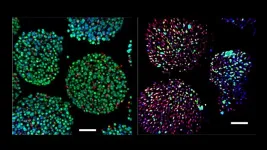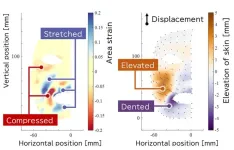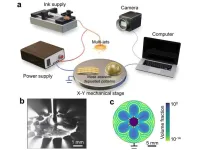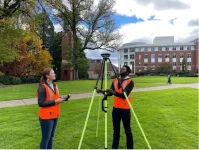(Press-News.org) Joint press release Utrecht University and Natural History Museum Maastricht
The cradle of palaeontology – the study of fossil remains of animals and plants – lies in the Maastricht limestones, where the first Mosasaurus was discovered in 1766. The Dutch-Belgian border area around the Limburg capital is one of the best-explored areas in the world where Cretaceous rocks are concerned, the era that came to an abrupt end 66 million years ago. New data can now be added to all previous knowledge: the Maastricht mosasaurs turned out to be quite picky in their choice of diet. This is the conclusion of researchers from Utrecht University and the Natural History Museum Maastricht. In collaboration with English colleagues from the University of Leicester, they were the first in the world to study the wear marks on mosasaur teeth.
"We were curious whether different species of mosasaurs around Maastricht were really getting in each other's way in their choice of food, or whether this was not so much of a problem," explains Dr Femke Holwerda, palaeontologist at the Utrecht University Faculty of Geosciences. In the absence of data on stomach contents of the Maastricht monitor lizards, the researchers therefore looked at minute scratches on the teeth of these animals from southern Limburg (the Netherlands) and in the vicinity of Eben-Emael (province of Liège, Belgium).
Seafood banquet
"It seems that the various species of mosasaur reveal differences in diet. We noted these differences mainly between the smaller species - by mosasaur standards - of about three to seven metres in overall size, and the larger ones, eight to fifteen metres in length.” But there were also some differences between the larger species. “Prognathodon in particular, with its large cone-shaped teeth, appears to have had a surprising amount of shellfish in its diet, so it apparently loved its seafood buffet. Another species, Plioplatecarpus, with narrow pointed teeth, showed a striking number of signs of wear. Perhaps this species was also fond of fish with strongly scaled bodies.”
First
The researchers first made casts of the teeth in silicone rubber and put them in the 3D scanner. "This technique had already been used in dinosaurs, but we were the first to look at the teeth of mosasaurs in the same way," explains fellow palaeontologist Anne Schulp, also affiliated with Utrecht University.
Diversity
With this research, some missing pieces of the puzzle from the long-gone latest Cretaceous world are found. "We wish to understand diversity better," says Schulp. "And that is made easier for us because the animals studied all come from the same rocks, and therefore the same period. So instead of describing just one species, we look at the ecosystem as a whole."
Soft limestone
The limestone deposits around Maastricht are a goldmine for palaeontologists. Schulp: "Nowhere else in the world is the habitat of mosasaurus as well preserved as here. You can find them in very soft limestone, so wear and tear of the teeth from other causes may be ruled out."
Attraction
Of course, such an abundance of potential finds also exerts a great attraction on amateur palaeontologists. "There's nothing wrong with that," emphasises John Jagt, curator at the Natural History Museum Maastricht. "Amateur literally means 'enthusiast' and thanks to 250 years of intensive research by these enthusiasts, we have learnt a lot about mosasaurs and other extinct life forms. A museum like ours benefits greatly from this. What also helps is that this kind of amateur science is stimulated in the Netherlands: it is simply allowed by law. That's not the case everywhere."
Article
Femke M. Holwerda, Jordan Bestwick, Mark A. Purnell, John W.M. Jagt, Anne S. Schulp, ‘Three-dimensional dental microwear in type-Maastrichtian mosasaur teeth (Reptilia, Squamata)’, Scientific Reports, https://doi.org/10.1038/s41598-023-42369-7
END
Palaeo-CSI: Mosasaurs were picky eaters
Signs of wear on teeth betray dietary preferences
2023-11-09
ELSE PRESS RELEASES FROM THIS DATE:
AI algorithm developed to measure muscle development, provide growth chart for children
2023-11-09
Leveraging artificial intelligence and the largest pediatric brain MRI dataset to date, researchers have now developed a growth chart for tracking muscle mass in growing children. The new study led by investigators from Brigham and Women’s Hospital, a founding member of the Mass General Brigham healthcare system, found that their artificial intelligence-based tool is the first to offer a standardized, accurate, and reliable way to assess and track indicators of muscle mass on routine MRI. Their results were published today in Nature Communications.
“Pediatric cancer patients often struggle with low ...
A breath of fresh air keeps drug-producing cells alive longer
2023-11-09
Cell-based therapies show promise for drug delivery, replacing damaged tissues, harnessing the body’s own healing mechanisms and more
But keeping cells alive to produce therapies has remained a challenge
Researchers used a smart, energy-efficient version of water splitting to produce oxygen for these cells
New approach maintains cells in vitro and in vivo, showing promise for both acute and chronic applications
EVANSTON, Ill. — In 2021, a Northwestern University-led research team received a Defense Advanced Research Projects Agency (DARPA) contract worth up to $33 million to develop an ...
Smartphones and smart speakers may be able to detect alcohol intoxication by analyzing voice patterns: Study
2023-11-09
By Kimberly Flynn
PISCATAWAY, NJ—Sensors in smartphones and smart speakers could help determine a person’s level of alcohol intoxication based on the changes in their voice, according to a new study in the Journal of Studies on Alcohol and Drugs.
Researchers at Stanford Medicine and the University of Toronto conducted a small study of 18 adults ages 21 and up. Participants were given a weight-based dose of alcohol and randomly assigned a series of tongue twisters—one before drinking, and one each hour up to seven hours after drinking.
The participants were asked to read the tongue twister aloud, and a smartphone was placed on a table withing ...
Forests with multiple tree species are 70% more effective as carbon sinks than monoculture forests
2023-11-09
To slow the effects of climate change, conserve biodiversity, and meet the sustainable development goals, replanting trees is vital. Restored forests store carbon within the forest’s soil, shrubs, and trees. Mixed forests are especially effective at carbon storage, as different species with complementary traits can increase overall carbon storage. Compared to single-species forests, mixed forests are also more resilient to pests, diseases, and climatic disturbances, which increases their long-term carbon storage potential. The delivery of other ecosystem services is also greater in mixed species forests, and they support higher levels of biodiversity.
Although the benefits ...
Umbilical cord milking appears to be safe in preterm infants born after 28 weeks
2023-11-09
WHAT:
A treatment to move blood from the umbilical cord into an infant’s body may provide a safe option for preterm infants born after 28 weeks who need rapid support, suggests a study supported by the National Institutes of Health. The procedure, called umbilical cord milking, involves gently squeezing the cord between the thumb and forefinger and pushing the blood into the newborn’s abdomen. The new findings suggest that concerns raised by a 2019 study of infants born before 28 weeks—which concluded that umbilical cord milking might increase the risk of bleeding inside the brain—do not apply to preterm infants born after 28 weeks. The ...
How human faces can teach androids to smile
2023-11-09
Osaka, Japan – Robots able to display human emotion have long been a mainstay of science fiction stories. Now, Japanese researchers have been studying the mechanical details of real human facial expressions to bring those stories closer to reality.
In a recent study published by the Mechanical Engineering Journal, a multi-institutional research team led by Osaka University have begun mapping out the intricacies of human facial movements. The researchers used 125 tracking markers attached to a person’s face to closely examine 44 different, singular facial actions, such as blinking or raising the corner of the mouth.
Every facial expression comes with a variety of local deformation ...
Grant helps program expand distracted driving education to online learning
2023-11-09
The National Highway Traffic Safety Administration (NHTSA) estimates there were 42,795 deaths resulting from motor vehicle crashes in 2022 in the United States. This projection is close to the previous year fatality numbers, which were the highest in 16 years.
A Herbert Wertheim School of Public Health and Human Longevity Science at University of California San Diego program aims to improve safety for all roadway users, including drivers, pedestrians and cyclists with support from a $360,000 grant from the California Office of Traffic Safety through the NHTSA.
To inform and promote safe driving, the UC San Diego Training, Research and Education for Driving Safety (TREDS) provides ...
HKUST researchers develop low-cost and multifunctional microprinter for ultrafast piezoelectric material printing
2023-11-09
A research team led by The Hong Kong University of Science and Technology (HKUST) has developed a microprinter that can print piezoelectric films 100 times faster for the production of microelectromechanical systems (MEMS) for sensors, wearable or implantable medical devices, offering the possibility to lower the mass production costs.
The microprinter, built at a comparatively lower cost as compared with other printers on the market, utilizes an electrostatic field to propel streams of ink onto a platform, allowing for efficient manipulation of thin film patterns and enhanced printing speed to address the challenge of mass production ...
Oregon State to receive $6.5M for federal effort to modernize geospatial coordinate system
2023-11-09
CORVALLIS, Ore. – Oregon State University is one of four institutions selected to advance a federal effort to modernize the National Spatial Reference System, which underpins surveying, mapping, autonomous vehicle navigation, precision agriculture and the rest of the United States’ geospatial economy.
OSU will receive $6.5 million over five years from the National Oceanic and Atmospheric Administration for research to be conducted by the new Geospatial Center for the Arctic and Pacific, or GCAP. The funding is through NOAA’s National Geodetic Survey and is part of nearly $20 million awarded overall.
The other funding ...
The Lancet: Studying medicine, Nazism, and the Holocaust crucial to strengthening medical education and ethics today
2023-11-09
Peer-reviewed/ review, analysis and opinion
The Lancet: Studying medicine, Nazism, and the Holocaust crucial to strengthening medical education and ethics today
Most comprehensive report to date on medical atrocities under Nazism and during the Holocaust – and their implications for today – details the central role health professionals played in formulating and carrying out the antisemitic, racist, and inhumane policies and practices during the Nazi regime.
The Commission challenges long-held misconceptions about medicine in the Nazi era, including the claim that medical crimes were carried out by only a ...
LAST 30 PRESS RELEASES:
Rising temperatures reshape microbial carbon cycling during animal carcass decomposition in water
Achieving ultra-low-power explosive jumps via locust bio-hybrid muscle actuators
Plant-derived phenolic acids revive the power of tetracycline against drug-resistant bacteria
Cooperation: A costly affair in bacterial social behaviour?
Viruses in wastewater: Silent drivers of pollution removal and antibiotic resistance
Sub-iethal water disinfection may accelerate the spread of antibiotic resistance
Three in four new Australian moms struggle with body image
Post-stroke injection protects the brain in preclinical study
Cardiovascular risk score predicts multiple eye diseases
Health: estimated one in ten British adults used or interested in GLP-1 medications for weight loss
Exercise to treat depression yields similar results to therapy
Whooping cough vaccination for pregnant women strengthens babies’ immune system
Dramatic decline in new cases of orphanhood in Uganda driven by HIV treatment and prevention programs
Stopping weight loss drugs linked to weight regain and reversal of heart health markers
Higher intake of food preservatives linked to increased cancer risk
Mass General Brigham–developed cholera vaccine completes phase 1 trial
First experimental validation of a “150-year-old chemical common sense” direct visualization of the molecular structural changes in the ultrafast anthracene [4+4] photocycloaddition reaction
Lack of support for people on weight loss drugs leaves them vulnerable to nutritional deficiencies, say experts
Dogs’ dinners can have greater climate impact than owners’
Are you ready to swap salmon for sprats and sardines?
1.6 million UK adults used weight loss drugs in past year
American College of Cardiology comments on new dietary guidelines for Americans
American Society of Gene & Cell Therapy and Orphan Therapeutics Accelerator partner to advance and commercialize promising rare disease treatments
One in 14 patients having day case surgery have new or worse chronic pain 3 months after their operation
New study highlights link between eviction rates and gun violence
Heatwaves heat up soil but not toxin levels in rice, study finds
Digital modeling reveals where construction carbon emissions really come from
Turning farm waste into water filters
New study shows how the spleen helps the immune system accept a transplant
New Mayo Clinic study advances personalized prostate cancer education with an EHR-integrated AI agent
[Press-News.org] Palaeo-CSI: Mosasaurs were picky eatersSigns of wear on teeth betray dietary preferences





